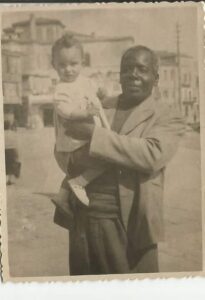Exchanged on the basis of religion: Muslims of African descent in Crete
City
Migration Period
Category
Full Description
The Population Exchange Agreement signed at the Lausanne Conference stipulated a mandatory exchange of populations between Greece and Turkey on the basis of religion. In the case of Crete, this meant that the majority of the Muslims who had to abandon the island were Cretans of Islamic faith. Besides those, however, there was also another Muslim population group in Chania: the African Muslims.
According to the literature, the African Muslims arrived in Crete in various periods, mostly after the Ottomans conquered the island in 1645, but also during the period of Egyptian rule (1830-1840). African Muslims did not constitute a homogenous community. The presence of certain African Muslim groups was visible in the city’s residential distribution. A settlement in the area of Koum Kapi was populated mostly by Africans who had arrived during the 19th century from the area of Benghazi, whom the locals called ‘Halikoutes’ or ‘Halikoutides’. Few photographs have survived depicting the faces of these people. It appears that as a group, the African Muslims of Chania performed the most demeaning manual labour, mainly carrying burden, cleaning cesspits, etc., jobs previously undertaken by slaves before slavery was abolished in the Ottoman Empire.
The case of these Muslims is indicative of how unnuanced and perfunctory the population exchange process was. For the African Muslims of Chania, just like for the Cretan Muslims and the Asia Minor Christians, the exchange meant abandoning their homeland and settling in places they had never seen before. Although most of them had been born and raised in Crete, as their families had arrived from Africa decades earlier, they were forced to move to Anatolia, a place entirely unfamiliar to them.
There are two well-known stories of Africans from Chania that still survive today, each one representing a different possible outcome for the island’s exchangeable Muslims. The first is the story of Ali Gogo and the second of Salis Chelidonakis.
Ali Gogo was from Congo, which probably explains the nickname ‘Gogo’. His appearance was impressive and he was a well-known figure around town, which was why he was immortalised in some photographs and postcards that survive to this day. He was a very tall, heavyset man, known for telling funny and lewd stories. He worked as a mule driver.
During the population exchange, it is said that Ali did not want to leave Chania. As the story goes, after he boarded the ship he jumped in the sea, but the crew picked him up and put him back on the ship by force. There is no information about what happened to him after that.
Ali’s character and presence in the city were preserved in the city’s oral tradition, which in turn was recorded in literature after Ali left Chania. In his book Tale of a Town, Pantelis Prevelakis wrote a scene featuring Madame Ortance, Ali Gogo and the admirals of the Great Powers. This colourful, literary encounter contains multiple political symbolisms and describes the decline of the Great Powers at the same time as Crete was trying to secure its independence from the Ottoman Empire and unite with Greece. Within this context, Ali Gogo is presented as a character who opportunistically attempts to take advantage of Ortance’s situation, but ends up in the same boat as her and eventually helps her.
In contrast, Salis Chelidonakis is an example of an African Muslim who remained in the city. He was born in Chania in 1884 and his family was from Sudan. It is said that he was well-known and well-loved among the people of Chania for having a mild personality and performing selfless acts throughout his life. He worked as a boatman.
During the population exchange, Salis, being a British citizen, did not leave Crete. He stayed in Chania, as did his sister, who died in 1967. His death became a matter of some concern for the community, as the Muslim cemetery was destroyed after the departure of the majority of the Cretan Muslims. The Municipality of Chania had come up with a temporary solution which allowed the few Muslims who had remained in the city to be buried in an area to the south of the city limits. However, because Salis was beloved by a lot of people, a group of local Christians proposed burying him elsewhere, taking the issue all the way to the Ecumenical Patriarchate, which granted permission for Salis’ remains to be disinterred and reburied in the Christian cemetery of Agios Loukas. The photographs included in this entry depict Salis in different time periods. In the first picture, he is probably posing in one of the local photo studios and appears to be quite young. The same goes for the next picture, where he was photographed in a popular local hangout. In the last picture, Salis is older, holding the child of a friendly family in his arms.
Over the past decades, the figure of Salis has inspired poets, directors, and songwriters. One example is the song ‘The black boatman’, with music and lyrics written by Loudovikos Ton Anogeion, a popular Cretan songwriter and singer.
Artistic creations inspired by people like Salis constitute a form of memory which essentially attests to the presence of ‘diverse’ people in Crete at the beginning of the century.
Bibliography
Charidimos A. Papadakis, Africans in Crete. Halikoutes, Rethymno 2008.
Giannis Lyviakis, ‘Following the traces of the Africans of Crete – Halikoutides’, Chaniotika Nea (17/07/2021).
Giorgos Pitsitakis, ‘Highlights from Ali Gogo’s life and actions in Chania’, Chaniotika Nea (15/11/2018).
Manolis Manousakas, ‘Photo-retrospectives in old Chania. 141. Cemeteries: the English, the Russian, the Muslim and the Jewish cemetery’, Routes supplement, Chaniotika Nea (16/11/2007).







